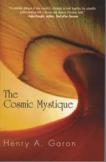God's Worldliness
In his poem God’s Grandeur, Gerard Manley Hopkins calls it the dearest freshness deep down things; and in his Book of Pilgrimage, Rainer Maria Rilke refers to it as the deep innerness of all things. What each poet strives to capture in words is the heart of matter beyond appearance, that essential nature of creation that reveals in its mysterious finitude the infinite mystery of God. In his own poetic style, Henry Garon explores this mystery at the heart of matter that he calls The Cosmic Mystique. A retired professor of physics at Loyola University, New Orleans, and an ordained married deacon in the Roman Catholic Church, Garon combines these two passions of his life to interpret the entities, processes and structures of the physical world observed by science through the lens of Christian doctrine, theology and spirituality. He accomplishes this task without theologizing science or scientizing theology. Rather, he engages in a viable dialogue between the two pursuits for meaning and truth in cosmic existence and understands these pursuits as mutually illuminative and transformative for persons of faith.
In 35 brief chapters, which Garon notes may be read sequentially or independently, he reflects on the endless extravaganza of the cosmos. He attempts to attune his readers to the whisperings of nature in order to hear, see and appreciate creation with senses alive to the wonder of life. To do so, Garon combines his personal experiences, his understanding of physics and the fruits of his theological formation with reflection questions at the end of each chapter to draw the reader into contemplation of the God-expression that is the natural world. His book pulses, implicitly and explicitly, with the theological lifeblood of Pierre Teilhard de Chardin, Karl Rahner and Thomas Berry. For Garon, as for Teilhard, Christ is the energy of the movement of the cosmos toward union with its creator. Like Rahner, creation for Garon is the venue through which God, who is essentially self-communicating, reveals the mystery of Godself. Like Berry, the cosmos has an allurement for Garon that draws him at every turn.
The journey into the mystique of the cosmos begins slowly as Garon seeks simply to engage the reader in the marvels at the hidden heart of physical reality. He does so in a thoroughly down-to-earth manner, exploring the wonders of light and radio waves, of stars and gravity, of bees and honey, of rust and even roadside litter. He delves into the meaning of meaning to suggest how commonly and how validly the human process of interpretation operates in the encounter of humans with one another and with non-human creation. In this way, Garon prepares the reader for the dialogue that he subsequently undertakes concerning what the insights of science might reveal about God and the God-world relationship.
This dialogue engages the impact of evolutionary science on theology and Christology. It investigates how God might be creative through the operation of chance in the cosmos, and it affirms how the world may reveal the very worldliness of God. It considers the possibility of the miraculous within the natural laws of the cosmos. Garon’s treatment of these questions and others like them is both careful and insightful. He seems to be aware that he takes the reader on a foray into territories that one must navigate with both sensitivity and courage. Garon proves to be a judicious guide on a delightful adventure into the mystical world of both science and scientists in dialogue with the Catholic Christian tradition.
Considering the influences of Teilhard and Rahner on his work, it is not surprising to find that Garon’s interpretation of the cosmos as God-expression is thoroughly Christocentric. While suggesting that the fullness of truth is called by many names in different cultures and religious traditions, for Garonand for committed Christians, according to GaronChrist is the way, the truth and the life of the cosmos. In the Incarnation, Christ is God-become-world, and the meaning of the world is most authentically to be found in the Christ-event.
This Christocentric emphasis, however, is not without consequence. The author’s emphasis sometimes communicates an exclusivity of interpretation that belies not only the meaning of meaning that Garon so ably sets forth, but also the essential unity-in-diversity that is a fundamental aspect of the cosmic mystique. Furthermore, this emphasis seems to express itself in a generally anthropocentric approach to creation and its creatures.
Garon frequently characterizes nonhuman creation in terms of serving the purposes, the development and the enhancement of humanity. He suggests that it is human recognition that gives meaningfulness to the cosmos and rescues it from insignificance. He notes that things are merely there until humans bestow worth and meaning upon them. Regrettably, this suggests that the value of nonhuman creation is essentially instrumental and subservient to human dominion. Instead, a cosmology fully based in an evolutionary understanding affirms the intrinsic value of all of creation in a web of interdependency of which humanity is an integral part.
Finally, in limiting his Christian perspective to an incarnational approach, Garon leaves little room in his cosmology for a fully Trinitarian treatment of the cosmic mystique. Within the science-theology dialogue, such a treatment understands God not only as embodied in the Word-made-flesh. It also recognizes God as ultimate source of cosmic being and as its continuous creator through the Holy Spirit, whose immanent presence and action in cosmic processes forever vivifies, sustains and renews the face of the earth.
This article also appeared in print, under the headline “God's Worldliness,” in the August 28, 2006, issue.








